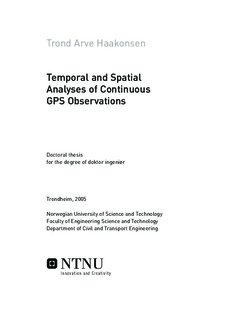| dc.contributor.author | Haakonsen, Trond Arve | nb_NO |
| dc.date.accessioned | 2014-12-19T11:26:13Z | |
| dc.date.available | 2014-12-19T11:26:13Z | |
| dc.date.created | 2005-11-29 | nb_NO |
| dc.date.issued | 2005 | nb_NO |
| dc.identifier | 125780 | nb_NO |
| dc.identifier.isbn | 82-471-7230-5 | nb_NO |
| dc.identifier.uri | http://hdl.handle.net/11250/231380 | |
| dc.description.abstract | The objective of this thesis is to increase the understanding of land motion, using statistical analysis of the available three-dimensional (3-D) time series from Continuously operated Global Positioning System stations (CGPS). A primary goal has been to search for new procedures and determine a spectrum of univariate CGPS time series. A new program package has been developed for adjustment and spectral analysis of the CGPS time series for possible future studies. This will take into account the possibility of weighting and managing, non-stationary and time series with missing data. The least squares spectrum and its relation to covariance and correlation functions are explained in detail. Different estimation methods of such functions that are used to visualise temporal correlations have been tested. A challenge of the work has been the handling data jumps revealed in the numerical investigations, that vitally affect the estimation of correlation functions and spectra.
The work has also included numerical analyses of two independently pre-processed data sets from a Norwegian and a European network of CGPS. The spectral analysis has shown large contributions of annual cycles for most series. In addition semi-annual and three-month cycles have been found. After the removal of these effects, the resulting spectra estimated from the residual series of CGPS time series shows similarities with Markov-processes that are closely related to white noise processes. The detection of a Chandler-like period is more surprising because this period should have been corrected for in the pre-processing stage of CGPS time series. A Principal Component Analysis (PCA) has been implemented to determine the spatial pattern of CGPS data. So far this has not been performed either for a network of Norwegian CGPS stations or for a network covering the whole of Europe. The results from both analyses confirm that the first mode obtained up to 50 percent of the overall variance in all station series. In addition to a high inter-station correlation, only slightly decreasing as a function of distance, this implies at least one common effect for the entire network. The spatial and partially temporal pattern for the first three modes in CGPS data show similarity with corresponding modes extracted from predictions of atmospheric loading of surface displacements. These relations have been further investigated for the purpose of deriving possible model relations. Numerical investigations using the derived models to correct the CGPS data for the atmospheric loading effect have shown a possible sample variance reduction of up to 10 percent for the vertical component of CGPS data. | nb_NO |
| dc.language | eng | nb_NO |
| dc.publisher | Fakultet for ingeniørvitenskap og teknologi | nb_NO |
| dc.relation.ispartofseries | Doktoravhandlinger ved NTNU, 1503-8181; 2005:171 | nb_NO |
| dc.title | Temporal and Spatial Analyses of Continuous GPS Observations | nb_NO |
| dc.type | Doctoral thesis | nb_NO |
| dc.contributor.department | Norges teknisk-naturvitenskapelige universitet, Fakultet for ingeniørvitenskap og teknologi, Institutt for bygg, anlegg og transport | nb_NO |
| dc.description.degree | dr.ing. | nb_NO |
| dc.description.degree | dr.ing. | en_GB |
